The snake plant (Sansevieria trifasciata, now officially Dracaena trifasciata) is one of the most popular, resilient, and beginner-friendly houseplants. With its striking sword-shaped leaves and air-purifying qualities, it’s a must-have for any indoor plant lover. Even better — snake plants are incredibly easy to propagate, allowing you to multiply your collection or share cuttings with friends.
In this guide, we’ll break down easy, effective snake plant propagation methods, including step-by-step instructions, care tips, and common mistakes to avoid. Whether you’re a seasoned gardener or new to houseplants, you’ll find these techniques simple and rewarding.
Why Propagate Snake Plants?

Propagation is an excellent way to:
- Expand your plant collection for free
- Share plants as gifts
- Rescue and rejuvenate overgrown or damaged plants
- Create beautiful arrangements from a single plant
Snake plants are especially ideal for propagation because of their hardy, adaptable nature and multiple propagation options.
4 Easy Methods for Propagating Snake Plants
Snake plants can be propagated through:
- Leaf cuttings in water
- Leaf cuttings in soil
- Division of root clumps
- Rhizome propagation
Let’s explore each method in detail.
Method 1: Propagating Snake Plant in Water

This is the most beginner-friendly and visually satisfying method, as you can watch the roots grow.
What You’ll Need:
- Sharp, clean scissors or garden shears
- Healthy snake plant leaves
- Glass jar or vase
- Clean, filtered water
Steps:
- Choose a healthy leaf:
Select a firm, disease-free leaf from the mother plant. - Cut the leaf:
Use sharp scissors to cut the leaf near the base. - Divide into sections (optional):
You can cut the leaf into several 4–5 inch pieces. Remember to keep track of which end was the bottom — it’s important to plant the right end down. - Place in water:
Submerge the cut end of the leaf in a jar of clean water. Ensure only the bottom part is underwater. - Provide light:
Place the jar in a spot with bright, indirect light. - Change water regularly:
Refresh the water every 3–5 days to prevent rot. - Wait for roots:
Roots typically appear within 3–6 weeks, followed by small pups. - Transplant to soil:
Once roots are 1–2 inches long, plant the cutting in well-draining potting soil.
Method 2: Propagating Snake Plant in Soil
This method skips the water rooting phase and plants cuttings directly into soil.
What You’ll Need:
- Healthy snake plant leaves
- Potting soil (well-draining cactus or succulent mix)
- Small pots with drainage holes
- Sharp scissors
Steps:
- Cut a healthy leaf:
Choose a firm, healthy leaf and cut it near the base. - Divide into sections (optional):
As with the water method, cut into 4–5 inch sections if desired. - Allow to dry:
Let the cut ends callous over for 1–2 days. This prevents rot. - Plant in soil:
Insert the cut end about 1–2 inches deep into slightly moist, well-draining soil. - Water lightly:
Keep the soil just barely moist until roots form, then water only when dry. - Provide bright, indirect light:
Avoid harsh sun that might scorch the cuttings. - Wait for new growth:
New roots should form in 4–6 weeks, and pups will follow.
Method 3: Propagating by Division

Division is the fastest way to propagate a mature snake plant and is ideal if your plant has outgrown its pot.
What You’ll Need:
- Sharp knife or garden shears
- Mature snake plant
- New pots with well-draining soil
Steps:
- Remove the plant from its pot:
Carefully tip the pot and ease the plant out. - Loosen the root ball:
Gently shake off excess soil to expose the roots and rhizomes. - Identify natural divisions:
Look for clumps of leaves connected by rhizomes with their own roots. - Cut the divisions:
Use a sharp, clean knife to separate each clump, ensuring each has roots attached. - Replant divisions:
Plant each new clump in a pot filled with fresh, well-draining soil. - Water sparingly:
Lightly water after repotting and avoid overwatering.
Method 4: Propagating by Rhizome
Snake plants produce underground horizontal stems called rhizomes. New shoots or pups often grow from these.
Steps:
- Locate rhizomes:
Remove the plant from its pot and look for thick, white rhizomes under the soil. - Cut rhizomes:
Using a sterilized knife, cut sections of rhizome with at least one node (growth point). - Let cuts dry:
Allow rhizome pieces to dry for a day to prevent rot. - Plant in soil:
Bury the rhizomes slightly under well-draining soil. - Water sparingly and wait for growth.
Ideal Growing Conditions for Snake Plant Propagation

Light:
Bright, indirect sunlight is ideal. Avoid direct midday sun, especially for cuttings.
Temperature:
Optimal temperatures range from 65–85°F (18–29°C). Protect cuttings from cold drafts.
Water:
Snake plants are drought-tolerant. Water sparingly, keeping soil barely moist during propagation.
Humidity:
Average indoor humidity is fine; avoid overly humid conditions to prevent rot.
Best Soil for Snake Plant Propagation
Use a well-draining potting mix:
- Cactus or succulent mix
- Or blend regular potting soil with sand, perlite, or pumice for drainage
Good drainage is crucial to prevent root rot, especially for water-storing snake plants.
Common Problems and How to Avoid Them
Rotting leaves or cuttings:
- Cause: Overwatering or insufficient drying before planting.
- Solution: Let cuttings callous and avoid soggy soil.
No root growth:
- Cause: Low light or cold temperatures.
- Solution: Move to a brighter, warmer spot.
Mushy rhizomes:
- Cause: Waterlogged soil.
- Solution: Use a fast-draining mix and ensure pots have drainage holes.
How Long Does Snake Plant Propagation Take?

Water propagation:
Roots in 3–6 weeks, pups in 2–3 months
Soil propagation:
Roots in 4–6 weeks, pups in 2–4 months
Division:
Instant new plants ready to grow
Rhizome:
New shoots appear in 4–8 weeks
Final Thoughts
Propagating snake plants is an easy, satisfying project for plant lovers of all skill levels. Whether you choose water, soil, division, or rhizome methods, you’ll find snake plants forgiving and rewarding to multiply.
With minimal equipment, bright light, and patience, you can turn a single plant into a lush indoor jungle, create thoughtful plant gifts, or fill your home with their beautiful, air-purifying foliage.
So grab those scissors, find a sunny windowsill, and start your snake plant propagation adventure today!





Leave A Comment